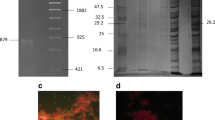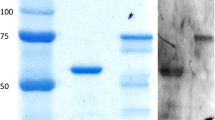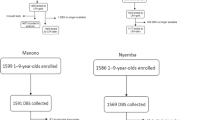Abstract
Screening for Chlamydia trachomatis-specific antibodies is valuable in investigating recurrent miscarriage, tubal infertility and extrauterine pregnancy. We compared here the performance of immunofluorescence (IF) to four other commercial tests in detecting IgG antibodies directed against C. trachomatis: two enzyme-linked immunosorbent assays (ELISAs) using the major outer membrane protein (MOMP) as the antigen, commercialised respectively by Medac and R-Biopharm (RB), one ELISA using the chlamydial heat shock protein 60 (cHSP60) as the antigen (Medac), as well as a new automated epifluorescence immunoassay (InoDiag). A total of 405 patients with (n = 251) and without (n = 154) miscarriages were tested by all five tests. The prevalence of C. trachomatis-specific IgG antibodies as determined by the IF, cHSP60-Medac, MOMP-Medac, MOMP-RB and InoDiag was 14.3, 23.2, 14.3, 11.9 and 26.2%, respectively. InoDiag exhibited the highest sensitivity, whereas MOMP-RB showed the best specificity. Cross-reactivity was observed with C. pneumoniae using IF, MOMP-RB and InoDiag, and Parachlamydia acanthamoebae using the cHSP60 ELISA test. No cross-reactivity was observed between C. trachomatis and the other Chlamydiales (Neochlamydia hartmannellae, Waddlia chondrophila and Simkania negevensis). Given its high sensitivity, the new automated epifluorescence immunoassay from InoDiag represents an interesting alternative. The MOMP-based ELISA of R-Biopharm should be preferred for large serological studies, given the high throughput of ELISA and its excellent specificity.
Similar content being viewed by others
References
Peipert JF (2003) Clinical practice. Genital chlamydial infections. N Engl J Med 349:2424–2430
Manavi K (2006) A review on infection with Chlamydia trachomatis. Best Pract Res Clin Obstet Gynaecol 20:941–951
Spiliopoulou A, Lakiotis V, Vittoraki A, Zavou D, Mauri D (2005) Chlamydia trachomatis: time for screening? Clin Microbiol Infect 11:687–689
Fine D, Dicker L, Mosure D, Berman S (2008) Increasing chlamydia positivity in women screened in family planning clinics: do we know why? Sex Transm Dis 35:47–52
Baud D, Jaton K, Bertelli C, Kulling JP, Greub G (2008) Low prevalence of Chlamydia trachomatis infection in asymptomatic young Swiss men. BMC Infect Dis 8:45
Lind I, Bollerup AC, Farholt S, Hoffmann S (2009) Laboratory surveillance of urogenital Chlamydia trachomatis infections in Denmark 1988–2007. Scand J Infect Dis 41:334–340
Kløvstad H, Aavitsland P (2009) Chlamydia trachomatis infections in Norway, 1986 to 2006, surveillance data. Sex Transm Dis 36:17–21
Sangani P, Rutherford G, Wilkinson D (2004) Population-based interventions for reducing sexually transmitted infections, including HIV infection. Cochrane Database Syst Rev 2:CD001220
Simonetti AC, Melo JH, de Souza PR, Bruneska D, de Lima Filho JL (2009) Immunological’s host profile for HPV and Chlamydia trachomatis, a cervical cancer cofactor. Microbes Infect 11:435–442
Baud D, Regan L, Greub G (2008) Emerging role of Chlamydia and Chlamydia-like organisms in adverse pregnancy outcomes. Curr Opin Infect Dis 21:70–76
Mårdh PA (2002) Influence of infection with Chlamydia trachomatis on pregnancy outcome, infant health and life-long sequelae in infected offspring. Best Pract Res Clin Obstet Gynaecol 16:847–864
Arya R, Mannion PT, Woodcock K, Haddad NG (2005) Incidence of genital Chlamydia trachomatis infection in the male partners attending an infertility clinic. J Obstet Gynaecol 25:364–367
den Hartog JE, Lardenoije CM, Severens JL, Land JA, Evers JL, Kessels AG (2008) Screening strategies for tubal factor subfertility. Hum Reprod 23:1840–1848
Machado AC, Guimarães EM, Sakurai E, Fioravante FC, Amaral WN, Alves MF (2007) High titers of Chlamydia trachomatis antibodies in Brazilian women with tubal occlusion or previous ectopic pregnancy. Infect Dis Obstet Gynecol 24816
Ness RB, Soper DE, Richter HE, Randall H, Peipert JF, Nelson DB, Schubeck D, McNeeley SG, Trout W, Bass DC, Hutchison K, Kip K, Brunham RC (2008) Chlamydia antibodies, chlamydia heat shock protein, and adverse sequelae after pelvic inflammatory disease: the PID Evaluation and Clinical Health (PEACH) Study. Sex Transm Dis 35:129–135
Dowell SF, Peeling RW, Boman J, Carlone GM, Fields BS, Guarner J, Hammerschlag MR, Jackson LA, Kuo CC, Maass M, Messmer TO, Talkington DF, Tondella ML, Zaki SR (2001) Standardizing Chlamydia pneumoniae assays: recommendations from the Centers for Disease Control and Prevention (USA) and the Laboratory Centre for Disease Control (Canada). Clin Infect Dis 33:492–503
Jones CS, Maple PA, Andrews NJ, Paul ID, Caul EO (2003) Measurement of IgG antibodies to Chlamydia trachomatis by commercial enzyme immunoassays and immunofluorescence in sera from pregnant women and patients with infertility, pelvic inflammatory disease, ectopic pregnancy, and laboratory diagnosed Chlamydia psittaci/Chlamydia pneumoniae infection. J Clin Pathol 56:225–229
Mouton JW, Peeters MF, van Rijssort-Vos JH, Verkooyen RP (2002) Tubal factor pathology caused by Chlamydia trachomatis: the role of serology. Int J STD AIDS 13(Suppl 2):26–29
Verkooyen RP, Peeters MF, van Rijsoort-Vos JH, van der Meijden WI, Mouton JW (2002) Sensitivity and specificity of three new commercially available Chlamydia trachomatis tests. Int J STD AIDS 13(Suppl 2):23–25
Land JA, Gijsen AP, Kessels AG, Slobbe ME, Bruggeman CA (2003) Performance of five serological chlamydia antibody tests in subfertile women. Hum Reprod 18:2621–2627
Bax CJ, Mutsaers JA, Jansen CL, Trimbos JB, Dörr PJ, Oostvogel PM (2003) Comparison of serological assays for detection of Chlamydia trachomatis antibodies in different groups of obstetrical and gynecological patients. Clin Diagn Lab Immunol 10:174–176
Gazzard CM, Wood RN, Debattista J, Allan JA, Allan JM, Timms P (2006) Use of a commercial assay for detecting the 60 kDa chlamydial heat shock protein in a range of patient groups. Sex Transm Dis 33:77–79
Dutta R, Jha R, Salhan S, Mittal A (2008) Chlamydia trachomatis-specific heat shock proteins 60 antibodies can serve as prognostic marker in secondary infertile women. Infection 36:374–378
Bax CJ, Dörr PJ, Trimbos JB, Spaargaren J, Oostvogel PM, Peña AS, Morré SA (2004) Chlamydia trachomatis heat shock protein 60 (cHSP60) antibodies in women without and with tubal pathology using a new commercially available assay. Sex Transm Infect 80:415–416
Gouriet F, Levy PY, Samson L, Drancourt M, Raoult D (2008) Comparison of the new InoDiag automated fluorescence multiplexed antigen microarray to the reference technique in the serodiagnosis of atypical bacterial pneumonia. Clin Microbiol Infect 14:1119–1127
Gouriet F, Samson L, Delaage M, Mainardi JL, Meconi S, Drancourt M, Raoult D (2008) Multiplexed whole bacterial antigen microarray, a new format for the automation of serodiagnosis: the culture-negative endocarditis paradigm. Clin Microbiol Infect 14:1112–1118
Gouriet F, Drancourt M, Raoult D (2006) Multiplexed serology in atypical bacterial pneumonia. Ann NY Acad Sci 1078:530–540
Raoult D, Fournier PE, Drancourt M (2004) What does the future hold for clinical microbiology? Nat Rev Microbiol 2:151–159
Baud D, Thomas V, Arafa A, Regan L, Greub G (2007) Waddlia chondrophila, a potential agent of human fetal death. Emerg Infect Dis 13:1239–1243
Baud D, Peter O, Langel C, Regan L, Greub G (2009) Seroprevalence of Coxiella burnetii and Brucella abortus among pregnant women. Clin Microbiol Infect 15:499–501
Corsaro D, Greub G (2006) Pathogenic potential of novel Chlamydiae and diagnostic approaches to infections due to these obligate intracellular bacteria. Clin Microbiol Rev 19:283–297
Morré SA, Munk C, Persson K, Krüger-Kjaer S, van Dijk R, Meijer CJ, van den Brule AJ (2002) Comparison of three commercially available peptide-based immunoglobulin G (IgG) and IgA assays to microimmunofluorescence assay for detection of Chlamydia trachomatis antibodies. J Clin Microbiol 40:584–587
Gnarpe J, Nääs J, Lundbäck A (2000) Comparison of a new commercial EIA kit and the microimmunofluorescence technique for the determination of IgG and IgA antibodies to Chlamydia pneumoniae. APMIS 108:819–824
Messmer TO, Martinez J, Hassouna F, Zell ER, Harris W, Dowell S, Carlone GM (2001) Comparison of two commercial microimmunofluorescence kits and an enzyme immunoassay kit for detection of serum immunoglobulin G antibodies to Chlamydia pneumoniae. Clin Diagn Lab Immunol 8:588–592
Bergström K, Domeika M, Vaitkiene D, Persson K, Mårdh PA (1996) Prevalence of Chlamydia trachomatis, Chlamydia psittaci and Chlamydia pneumoniae antibodies in blood donors and attendees of STD clinics. Clin Microbiol Infect 1:253–260
Bas S, Muzzin P, Ninet B, Bornand JE, Scieux C, Vischer TL (2001) Chlamydial serology: comparative diagnostic value of immunoblotting, microimmunofluorescence test, and immunoassays using different recombinant proteins as antigens. J Clin Microbiol 39:1368–1377
Morré SA, Ossewaarde JM, Lan J, van Doornum GJ, Walboomers JM, MacLaren DM, Meijer CJ, van den Brule AJ (1998) Serotyping and genotyping of genital Chlamydia trachomatis isolates reveal variants of serovars Ba, G, and J as confirmed by omp1 nucleotide sequence analysis. J Clin Microbiol 36:345–351
Acknowledgements
We thank Sébastien Aeby for the technical help and André Baud for the computer assistance. David Baud is supported by the “Société Académique Vaudoise” through the “Paul Blanc” grant and the SICPA Foundation. Lesley Regan is grateful for support from the NIHR Biomedical Research Centre Funding Scheme. Research performed by the Greub Group is currently supported by the Swiss National Science Foundation (grant nos. FN 3200BO-116445 and 124483), by the Infectigen Foundation (In010), by the University of Lausanne and by SUEZ-ONDEO (Paris, France). Gilbert Greub is supported by the Leenards Foundation through a “Bourse Leenards pour la relève académique en médecine clinique à Lausanne”.
Author information
Authors and Affiliations
Corresponding author
Rights and permissions
About this article
Cite this article
Baud, D., Regan, L. & Greub, G. Comparison of five commercial serological tests for the detection of anti-Chlamydia trachomatis antibodies. Eur J Clin Microbiol Infect Dis 29, 669–675 (2010). https://doi.org/10.1007/s10096-010-0912-4
Received:
Accepted:
Published:
Issue Date:
DOI: https://doi.org/10.1007/s10096-010-0912-4




